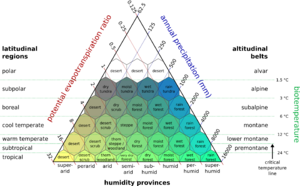World generation
The world is generated through a variety of different features procedurally generating to organically form different environments. Rather than discrete biomes, regions are formed through mechanics such as temperature, rocks, tree density, and water density.
Rock Layer Generation
Rock layers come in three general categories: igneous, metamorphic, and sedimentary. Each category of rocks has several specifc types of rocks in it, and when generating in the world, There can be multiple layers of each type (or none). The type of rocks has no effect on any flora or fauna generation. However it has a huge effect on what ores you may find in the area.
Tree Generation
Trees generate with different densities across the landscape, with some tree shapes only available through world generation that cannot be regrown.
Forestation and Shrubs
Natural Resources
When exploring, there are different natural resources that the average explorer may be interested in.
Sticks
Bones can substitute for sticks in some recipes. Bones may sometimes be found on carcasses of animals even if the player did not kill any.
Reed
Reeds are essential for many early recipes. Cattails are common near water in temperate regions. Papyrus can substitute for cattails in most recipes, and are common near water in warm regions.
Clay
Clay forms on the surface of the world, appearing in the form of either blue clay or fire clay. Clay does not generate in extreme hot or extreme cold climates.
Fire clay can make the same items as blue clay, as well as some unique items related to higher temperatures.
Ores
Ore Deposits generate all over the underground in Vintage Story. It is very important to pay attention to the type of rocks that are nearby, as ores will only form in specific rock types.
A nugget of ore on the earth's surface indicates more of that ore not far below, in blocks that need a pickaxe to break.
Rocks
Underneath the surface lies a large variety of different type of rocks. There are 22 different types of rocks, and each rock hosts a different selection of ores.
The type of small stones on the earth's surface indicate the type of rock directly below. Different rock types might be even deeper.
Soil
Different types of soil form over the landscape to form the surface. Some are more rare than others, with low fertility soil being the most common. The varying soil types have different levels of fertility, you may have to keep this in mind when choosing a location.
The rainfall amount seems to be directly tied to the average soil fertility, as 'very rare rainfall' correlates with almost only low fertility (or non at all) soil, whilst 'rain almost all the time' translates into almost only medium fertility soil.
Crops
Crops or Wild Foods spawn once on world generation and very slowly grow while the chunk is loaded. A mature crop resets back to stage 1 eventually. They however do not multiply.
Temperature
The temperature is a vital part of deciding what wild foods can generate, whether or not clay can form, and even which entities can spawn.
Weather
A region has a set of weather parameters that apply. An area of common rainfall might have higher fertility soil than a dry area, even if it doesn't rain for long stretches of time.
In general, areas that are more green indicate a larger amount of rainfall.
Winter conditions depend on latitude, altitude, and precipitation. Snowmelt might occur later in the year in northern areas, or on higher hills. Lack of snow doesn't necessarily mean it's warm enough for crops to survive.
Water
Environments are formed with varying levels of water density, this means that oceans, for example, are not force as a 'biome' but instead form organically.
Entities
Which animals the player will encounter is affected by the climate of the area. Creature spawning rules are tied to minimum and maximum temperature, as well as rainfall constraints, forestation constraints, and elevation constraints.
Structures
Structures form over the world's surface and underground in the form of ruins. These structures often contain loot that can benefit survival in various ways. Some blocks, such as aged wooden planks, can only be found in these ruins.
History
The ability to reduce landcover was added, so players can configure the size of oceans and the distance between landmasses.
Notes
Gallery
See also
References
| Wiki Navigation | |
|---|---|
| Vintage Story | Guides • Frequently Asked Questions • Soundtrack • Versions • Controls |
| Game systems | Crafting • Knapping • Clay forming • Smithing • Cooking • Temperature • Hunger • Mining • Temporal stability • Mechanical power • Trading • Farming • Animal husbandry |
| World | World generation • Biomes • Weather • Temporal storms |
| Items | Tools • Weapons • Armor • Clothing • Bags • Materials • Food |
| Blocks | Terrain • Plants • Decorative • Lighting • Functional • Ore |
| Entities | Hostile entities • Animals • NPCs • Players |
| Miscellaneous | List of client commands • List of server commands • Creative Starter Guide • Bot System • WorldEdit • Cinematic Camera • Adjustable FPS Video Recording • ServerBlockTicking |
